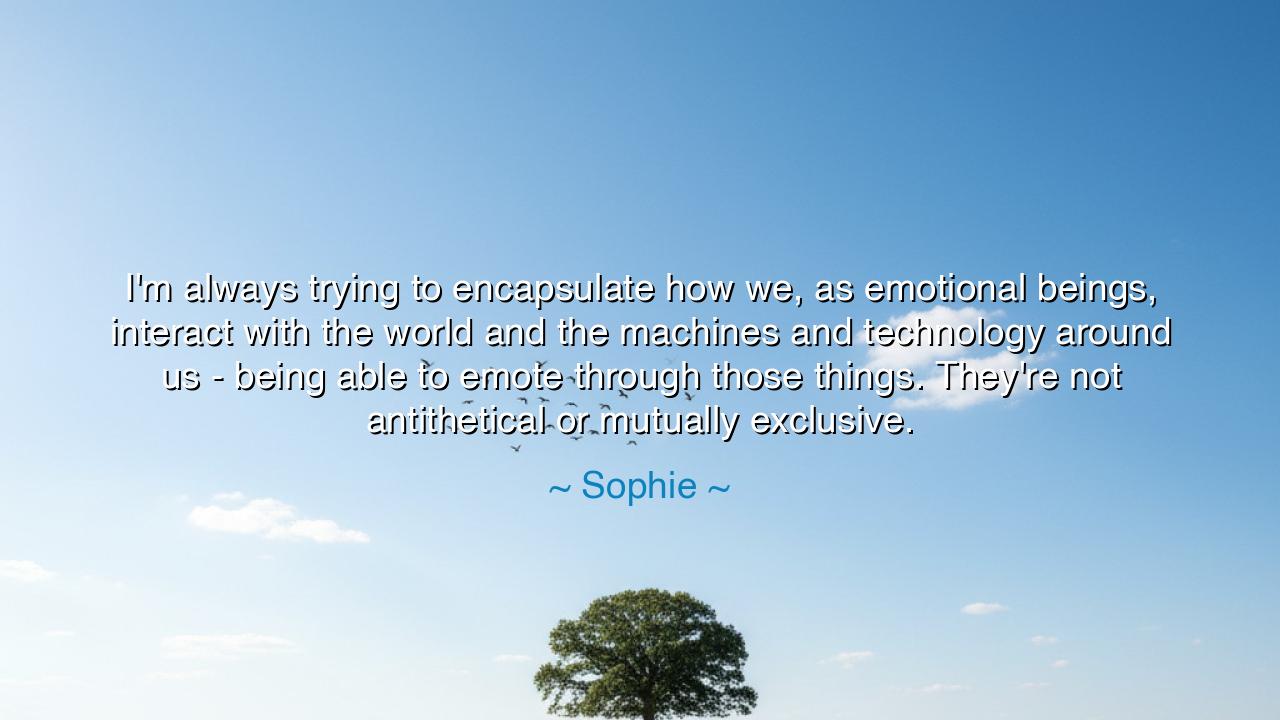
I'm always trying to encapsulate how we, as emotional beings
I'm always trying to encapsulate how we, as emotional beings, interact with the world and the machines and technology around us - being able to emote through those things. They're not antithetical or mutually exclusive.






The words of Sophie, the visionary artist and producer, rise like a hymn to the modern age: “I’m always trying to encapsulate how we, as emotional beings, interact with the world and the machines and technology around us—being able to emote through those things. They’re not antithetical or mutually exclusive.” In these words lies a truth both ancient and new: that the human heart and the creations of human hands are not enemies, but companions. The soul and the machine need not war against one another; rather, they may sing together, weaving emotion and mechanism into one living fabric.
From the dawn of time, humankind has shaped tools to extend its spirit. The lyre of Orpheus was no less a machine than the computer of today; both served to carry feeling beyond the body of the player. The ancients carved stone to build temples where prayers could dwell, just as the modern musician bends circuits and sound waves to channel grief, joy, and ecstasy. Thus, when Sophie declares that technology and emotion are not mutually exclusive, she speaks in continuity with all who have ever sought to embody the ineffable within the material.
Consider the story of Beethoven, who, when deafness consumed his hearing, turned to the instrument as if it were a living vessel of his inner storms. Though he could no longer hear the notes with mortal ears, through the piano he poured the thunder and sorrow of his soul, crafting symphonies that shook the world. Here was a man whose emotions did not perish in silence but were transmitted through the very machinery of music. His struggle reminds us of Sophie’s teaching: machines are not lifeless when infused with human passion; they become bridges between the heart and the cosmos.
Sophie's insight, born in the crucible of digital sound, is that in our time, technology is not merely utility—it is extension of self. To reject it as cold or alien is to misunderstand its potential. A synthesizer can weep; a digital voice can ache; an electronic beat can pulse with longing. Just as brush and canvas once carried the painter’s soul, so now the circuit and screen can carry ours. When Sophie sculpted sound, she showed that the sharp, metallic edge of technology could shimmer with tenderness, fragility, and raw humanity.
This truth carries a warning as well: to see machines as enemies is to cut ourselves off from tools that might expand the reach of our compassion and creativity. Yet it also carries responsibility: for tools amplify the spirit that wields them. In noble hands, they extend beauty; in careless hands, they magnify chaos. The bond of human and machine must be guided by wisdom and intention, lest the union become a distortion instead of a harmony.
Therefore, the lesson is clear: embrace technology not as master, nor as soulless servant, but as a partner in expression. Let it carry your voice farther, let it shape your visions more boldly, let it embody your emotions with new power. Do not fear its coldness, for it becomes warm when touched by your spirit. The brush does not paint itself; the instrument does not sing itself; neither does the computer create meaning without the fire of the human soul.
In practice, this means: do not hide from the tools of your age. Learn them, wield them, and bend them toward love, beauty, and truth. Let your emails carry kindness. Let your designs breathe empathy. Let your music, art, or creations—digital or physical—testify to the humanity that birthed them. See every machine as clay, and yourself as the sculptor whose emotions give it form.
So let Sophie’s words endure as a beacon: the human heart and the machine are not antithetical. They are two notes in the same song. When joined with care, they form a harmony that neither could achieve alone. Embrace this union, and you will find that the world itself—its circuits, its screens, its tools—becomes a choir through which your emotions echo into eternity.






AAdministratorAdministrator
Welcome, honored guests. Please leave a comment, we will respond soon